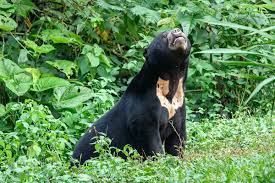Introduction:
In the dense rainforests of Southeast Asia, a creature roams the shadows with a radiant presence – the Sun Bear. Known for its unique appearance and intriguing behaviors, the Sun Bear holds a special place in the hearts of wildlife enthusiasts and conservationists alike. Join us on a journey to explore the fascinating world of the Sun Bear and uncover the mysteries of this charming forest dweller.

- Meet the Sun Bear:
The Sun Bear (Helarctos malayanus) is the smallest bear species in the world, measuring only 4 to 5 feet in length and weighing around 60 to 140 pounds. Its jet-black fur and a distinct yellowish-orange crescent on its chest earned it the nickname “Sun Bear.” Native to the rainforests of Southeast Asia, from India to Indonesia, this bear’s secretive nature has made it challenging to study in the wild.
- A Nose for Honey:
The Sun Bear is often referred to as the “honey bear” due to its strong affinity for honey and honeycomb. With a keen sense of smell, it can detect beehives from a considerable distance. Using its long tongue, the Sun Bear can easily access the sweet nectar hidden inside beehives, earning itself a place among the world’s best honey hunters.
- Unique Physical Adaptations:
The Sun Bear boasts several physical adaptations that make it well-suited for its forest habitat. Its long, sharp claws and powerful forelimbs enable it to climb trees with exceptional agility, allowing it to access fruits, insects, and honey high in the canopy. Additionally, its keen sense of smell helps it locate food sources hidden deep within the forest floor.
- Omnivorous Diet:
Sun Bears have a varied diet, making them omnivores. While they primarily consume fruits, honey, and insects, they are also known to eat small mammals, birds, eggs, and even carrion when the opportunity arises. This adaptability allows them to thrive in diverse forest ecosystems.
- Conservation Status and Threats:
Despite its adaptability, the Sun Bear faces numerous threats to its survival. Deforestation, habitat loss, and illegal hunting for bear parts and the pet trade have led to a decline in Sun Bear populations across their range. The International Union for Conservation of Nature (IUCN) lists the Sun Bear as Vulnerable, underscoring the urgent need for conservation efforts to protect this species.
- Elusive Behaviors:
The Sun Bear’s elusive nature makes it a challenging subject of study. It is primarily a solitary animal, except for mothers caring for their cubs. Its nocturnal habits and preference for dense forest cover further contribute to its elusive behavior, making it a rare sight for researchers and nature enthusiasts.
- Vital Role in Forest Ecosystems:
As an essential component of Southeast Asia’s forest ecosystems, the Sun Bear plays a crucial role in seed dispersal and maintaining forest health. By consuming fruits and dispersing seeds across vast distances, they contribute to forest regeneration and support the region’s rich biodiversity.
- Conservation Efforts:
Several organizations and initiatives are dedicated to the conservation of Sun Bears and their habitats. These efforts include raising awareness about the threats they face, establishing protected areas, and conducting research to better understand their ecology and behavior. Community-based conservation projects are also essential in engaging local communities in protecting the forests and the wildlife within.
Conclusion:
The Sun Bear’s striking appearance and elusive nature make it a captivating symbol of Southeast Asia’s wild landscapes. As we continue to discover and learn about these bears, it becomes increasingly evident that their survival is intricately linked to the conservation of their forest habitats. By joining forces to protect these precious forests, we can ensure that the Sun Bear continues to shine brightly in the wilderness for generations to come.



















Add Comment